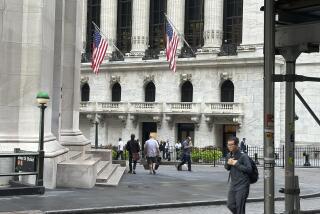Commodities are rapidly losing their luster
- Share via
The stampede into commodities has become a mad rush for the exits.
The market for raw materials staged a blistering retreat Thursday as fresh economic data revived worries about global economic growth and as selling fed on itself.
Crude oil in New York plunged almost $10 a barrel, with near-term futures closing below $100 a barrel for the first time in seven weeks. Silver, which had been on a tear this year, sank for the fourth straight day, leaving it down 25% from a 31-year high set a week ago.
The Thomson Reuters/Jefferies CRB index, a broad gauge of raw-material prices, sank 4.9% its fourth straight decline and its biggest drop this year. Of the index’s 19 components, only one — hog futures — rose for the day.
Traders said the sell-off was triggered in part by the government’s weekly report on first-time claims for unemployment benefits, which surged to 474,000 last week, the highest level in eight months and up 43,000 from the week before.
Although special factors such as temporary auto-plant shutdowns exaggerated the jump in claims, “even with these distortions accounted for, the result was still poor, and suggests some slowing of employment growth,” economists at Goldman Sachs said in a note to clients.
The jobless-claims report also clipped the stock market while driving some investors back to the classic haven of Treasury bonds, as Wall Street awaited the U.S. report Friday on April employment.
The Dow Jones industrial average slumped 139.41 points, or 1.1%, to 12,584.17, with energy stocks leading the way down. And demand for U.S. government securities sent Treasury yields sliding to their lowest levels of the year. The 10-year T-note’s yield, a benchmark for mortgage rates, sank to 3.15%, a six-month low, down from 3.22% on Wednesday.
Other data in recent days also have raised doubts about the pace of the economic recovery. A report Wednesday on the U.S. service sector showed a sharp slowdown in activity in April.
But many commodity traders say the economic data just offered a good excuse to bail out after the huge price gains of the last eight months.
“People feel the need to book profits and get on the side for a while,” said Frank Cholly, a commodities strategist at Lind-Waldock & Co.
The year’s hottest commodity, silver, was the first to crumble: After reaching a 31-year high of $48.58 an ounce April 29, the metal sank $2.51, or 5.2%, on Monday, then 7.6% on Tuesday and 7.5% on Wednesday.
On Thursday, silver was down 8% more, or $3.15, to $36.23 an ounce, as the Comex futures exchange continued to raise margin requirements to curb speculation. Margin is the minimum cash deposit investors must put up or maintain to trade futures.
Gold, which hit a record $1,556.70 an ounce Monday, tumbled $34, or 2.2%, on Thursday to end at $1,480.90.
Prices of most commodities have rocketed since August, in part on expectations that an improving economy would boost demand for materials. And because most commodities are priced in dollars, the greenback’s slide since August against other currencies has made materials cheaper for foreign investors to buy.
Many U.S. investors have been drawn to commodities, especially gold and silver, as a way to hedge against the risk of a further erosion in the dollar’s buying power.
But Thursday the dollar had its best rally of the year, further undercutting commodity prices. The euro, which had been streaking higher against the U.S. currency, slid 1.8% to $1.456 after the European Central Bank held short-term interest rates steady.
A rebound in the dollar “was long overdue, and it was only a matter of time before an event triggered it,” said Michael Woolfolk, currency strategist at Bank of New York Mellon.
More to Read
Inside the business of entertainment
The Wide Shot brings you news, analysis and insights on everything from streaming wars to production — and what it all means for the future.
You may occasionally receive promotional content from the Los Angeles Times.










